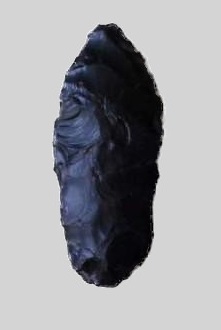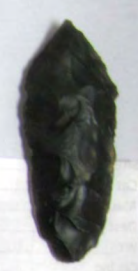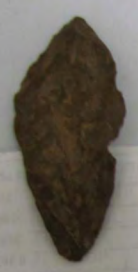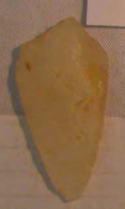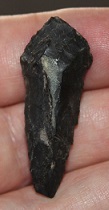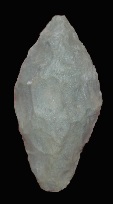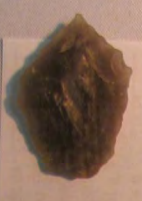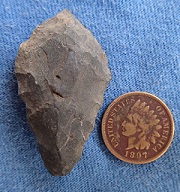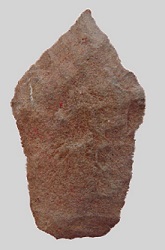Outline is Representative of Size and Shape:

Name Details:
Identified By: Charles Amsden
Named For: The Pleistocene Lake Mojave in southern California
Date Identified: 1937
Type Site: Lake Mojave Site
Identified By: Charles Amsden
Named For: The Pleistocene Lake Mojave in southern California
Date Identified: 1937
Type Site: Lake Mojave Site
Point Validity:
Valid type
Amsden was a distinguished anthropologist who began his work in archeology at the Southwestern Museum in Los Angles. He specialized in southwestern archaeology, specifically the Pueblo and Basketmaker. He named this type in a professional publication and it has many professional references. This is considered a valid type.
Amsden was a distinguished anthropologist who began his work in archeology at the Southwestern Museum in Los Angles. He specialized in southwestern archaeology, specifically the Pueblo and Basketmaker. He named this type in a professional publication and it has many professional references. This is considered a valid type.
Lake Mojave Stemmed
Cluster: Great Basin Stemmed Cluster Description of Physical Characteristics and Flaking Pattern:
This is a medium lanceolate point with a contracting stem. The cross section is diamond to elliptical. The blade is excurvate. Heavily re-sharpened examples may have a short stubby blade and a long stem. The shoulders are weak to absent and at an upward slope. Some examples have only one shoulder with the blade and stem being continuous on the opposite edge. The stem is contracting. The stem is long being one third the length of the blade to being longer than the blade. The base is convex. The hafting region has heavy grinding, thinning may be seen on the stem, but basal thinning is not present on this point. This point has a random flaking pattern.
Size Measurements:
Total Length - Total Length - 28 to 92 mm (average 35 to 50 mm), Stem Length - 22 to 45 mm (typically 1/2 to 3/4 the total length), Blade Width - 13 to 35 mm, Thickness - 6 to 11 mm
Total Length - Total Length - 28 to 92 mm (average 35 to 50 mm), Stem Length - 22 to 45 mm (typically 1/2 to 3/4 the total length), Blade Width - 13 to 35 mm, Thickness - 6 to 11 mm
Commonly Utilized Material:
Additional Comments:
Amsden differentiates the Lake Mojave from the Silver Lake type by:
Lake Mojave
1. Long tapering stem;
2. Slight (narrow) shoulders (if present);
3. Generally diamond-shaped with longer stem than blade; and
4. Varies in form between an oval form on one hand and diamond on the other.
By contrast, the Silver Lake type exhibits:
1. Greater definition of shoulder than the Lake Mojave type;
2. A shorter stem than the Lake Mojave type, never more than one-half the length and usually about one third of the length; and
3. Convex base.
Amsden differentiates the Lake Mojave from the Silver Lake type by:
Lake Mojave
1. Long tapering stem;
2. Slight (narrow) shoulders (if present);
3. Generally diamond-shaped with longer stem than blade; and
4. Varies in form between an oval form on one hand and diamond on the other.
By contrast, the Silver Lake type exhibits:
1. Greater definition of shoulder than the Lake Mojave type;
2. A shorter stem than the Lake Mojave type, never more than one-half the length and usually about one third of the length; and
3. Convex base.
Distribution:

Distribution Comments:
This point is primarily found in the dry lake areas of central California and into central Nevada. These points have not been reported into the coastal regions of California. Lake Mohave has been reported into northern Baja California and at the La Playa site in northern Sonora, Mexico.
This point is primarily found in the dry lake areas of central California and into central Nevada. These points have not been reported into the coastal regions of California. Lake Mohave has been reported into northern Baja California and at the La Playa site in northern Sonora, Mexico.
Age / Periods:
Date: 11,000 - 9,600 B.P.
Cultural Period:Transitional Paleo
Glacial Period: Late Pleistocene to Early Holocene
Culture: Western Stemmed Tradition
Date: 11,000 - 9,600 B.P.
Cultural Period:Transitional Paleo
Glacial Period: Late Pleistocene to Early Holocene
Culture: Western Stemmed Tradition
Age Details:
Other points in this cluster / Related / Associated Points:
Crescent, Cougar Mountain, Lind Coulee,Silver Lake
Crescent, Cougar Mountain, Lind Coulee,Silver Lake

